When Southwest Georgia filled with settlers, a movement for local government grew. In 1825 Thomas County was carved out of sprawling Irwin County and in 1831 Thomasville received her official charter. Much of the new county contained a variety of soils called the “hammock belt” which were more fertile than the “rolling wiregrass” of the surrounding area. This area of good soil was ideal for the production of cotton and rice, crops that were heavily dependent on slave labor. Slaves cleared the land and tilled the fields and were such an important part of the economics in Thomas County that their cash value was the measure of economic prosperity.
Slaves were a good investment during Thomas County’s ante-bellum history. Auctioneers sold slaves on the steps of the courthouse. Like a good mule, slaves received only a first name, which could be changed at any time by the master. African names, symbols of centuries of past culture, were obliterated, and the new arrivals became “Little Bob”, “Dark Sallie”, “Mose” and “Gimp”. Any white person who had enough money could buy a slave. In Thomas County large landowners purchased the majority of the slaves and used them for agricultural purposes on their plantations.
Plantation life in Thomas County varied among the different estates. Many factors influenced life on the plantations: the size of the property; the number of slaves and the type of crops planted. Each plantation in Thomas County was, of necessity, self-sufficient. Isolation, because of sparse settlement, coupled with inconvenient transportation, forced plantations to depend on themselves. Slaves worked from dawn to dusk doing a variety of work depending on their age, gender and the season of the year.
Many times an owner hired out his slaves who were sometimes paid for their work. Occasionally a slave earned enough money to buy his freedom. When Ephraim Ponder moved from 324 North Dawson Street in Thomasville in 1859, he could not afford to buy the wife and children of one of his slaves. That slave was Festus Flipper. Flipper had some money saved from work he had done as a shoemaker and carriage trimmer, which he used to buy his wife and children. One of those children grew up to become Lt. Henry Ossian Flipper, the first black American to graduate from the United States Military Academy. Lt. Flipper left West Point in 1877 and later became Assistant Secretary of Interior.
Slavery, as an established, legal system of bondage ended on May 8, 1865, when Federal Troops occupied Thomasville. The period of Reconstruction from 1865 to 1877 was the period of broken promises, abject poverty and crushed dreams for most black citizens in Thomas County. In theory, Reconstruction was a period when Blacks had an opportunity to become the social and political equals of their former masters, but having been subjected to slavery, Blacks were not prepared for the harsh realities of freedmen. They faced a hostile white environment. The presence of the military helped former slaves make an orderly transition to freedom, but could not force Whites to accept Blacks on an equal basis.
Many Blacks in Thomas County stayed on the plantations after emancipation. Many owners needing the labor of the freedmen invited them to stay. The Blacks who endured on the plantations continued to live and work as they had as slaves but they were better off economically than many of their counterparts elsewhere.
Schools for Blacks began immediately after the Civil War in Thomas County. Freedmen in the county converted vacant buildings into schools. Between 1867 and 1868, three to five black schools were in operation. Many members of the white community were happy that Blacks were educating themselves. The only fear the white community had of black education after the Civil War was the possibility that black children would attend school with white children. The School Act of 1870 backed away from mixed schools and called for public education for Blacks and Whites with separate-but equal-facilities. In 1872 the legislature amended the act changing to “equal as far as practical”. Black people of Thomas County sought more than the right to earn an education; they wanted political rights equal to those of their former masters. Blacks could not vote in Thomas County until April 1867. In the thirty-two years after 1877, the black population of Thomas County lost most of the civil and political rights gained during Reconstruction.
Education played a key roll in developing the black population. Charles Rice, a graduate in classics from Atlanta University, operated one of the better private black schools in Thomas County. His complex was called the Clay Street Normal and Industrial School. In 1886 the Connecticut Industrial School for Girls was established. It was later renamed the Allen Normal and Industrial School and became co-educational. The American Missionary Association sponsored it.
When emancipation came to the blacks, one of their first objectives was to set up their own churches. These churches grew rapidly in Thomas County and played a vital part in the social as well as religious life of the average black citizen. Many of these churches exist in some form even today.
Very few Blacks were financially well off in Thomas County between 1877 and 1909. However, some Blacks in the community managed to accumulate large fortunes considering their short times as freedmen. One former slave was Richard Hadley, Sr., born 1824; son of Simon Hadley, Sr., Richard saved $800.00 in gold and silver coins and purchased 250 acres of land on Trinity Road (Duncanville community) Beachton, Georgia, around 1870. Many acres of this land still remain in the family. There were many skilled and professional Blacks in Thomasville in the Post-Reconstruction years. They used talents developed during slavery; keeping stores in all kinds of businesses; filling nearly all the places as mechanics; building trades as carpenters, masons, plasterers, plumbers, and painters. Almost all blacksmiths, horseshoers and barbers were Black.
Note: Historical information was extracted from the book, The History of The Black Community of Thomas County, Georgia from 1827 to 1909, by Harold Henry Spangle, Jr., published by Thomas College Press, (1501 Millpond Road, Thomasville, Georgia 31792). This book is available as reference book in Thomasville through Thomas University, Jack Hadley Black History Museum and Thomas County Historical Society. It is out of print. Copies can also be circulated from any branch of the Thomas County Public Library System.
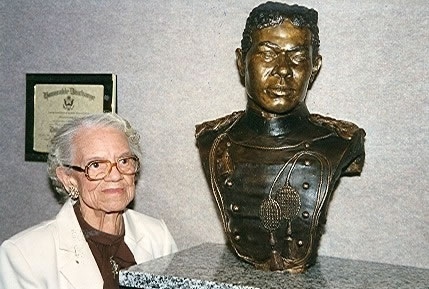
Thomas County Library Flipper Room, 102 North Madison Street
Lt. Henry Ossian Flipper was born a slave in Thomasville in 1856, yet he was the first Black to graduate from the United States Military Academy-West Point in 1877. As a Buffalo Soldier, he achieved many “FIRSTS” for Black Americans: West Point Academy graduate, cavalry officer, surveyor, cartographer, civil and mining engineer, translator, patented inventory, editor, author and special agent for the Justice Department. A bronze bust of Lt. Henry Ossian Flipper may be viewed at the Flipper Room located at the Thomas County Public Library, 102 North Madison Street.

Lt. Henry Ossian Flipper Park
800 North Broad Street
This park is dedicated in memory of Lt. Flipper who was born a slave in 1856. Lt. Flipper became the first Black American to graduate from the United States Military Academy – West Point in 1877.
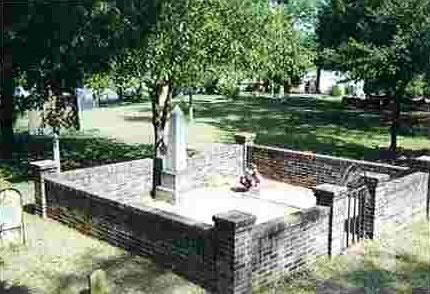
Lt. Ossian Flipper’s Grave and State of Georgia Landmark
700 North Madison Street
Lt. Flipper was reburied here in Thomasville on February 11, 1978, in Old Magnolia Cemetery.

Ephraim Ponder House
324 North Dawson Street
A classical revival eclectic, this structure was once a dormitory for Young’s Female College, (the large stone building behind this home). A breezeway connected the two buildings, and the Ponder Home had a large square cupola on the roof’s apex. These two architectural features no longer exist. The Ponder Home was later turned into a private residence as it remains today. Mr. Ponder owned the Flipper family slaves. Mr. Flipper’s son, Henry Ossian Flipper, became the First Black graduate of West Point in 1877.

Festus Flipper’s Home
430 Lester Street
A front gabled craftsman style cottage, Festus Flipper was a shoemaker and carriage trimmer. His business was located in the 200 block of South Broad Street, Thomasville. He was one of Lt. Henry O. Flipper’s brothers. He and his family lived in this home, which is now owned by Mr. Joe Watkins, who rent it to local citizens.
Old Magnolia Cemetery
700 North Madison Street
One of the oldest Black cemeteries in the city, African-Americans born in slavery and after 1865 are buried here. Dr. William A.J. Mosley, 1872 to1943; Mr. W.E. Gibson, 1866 to 1953; Festus Flipper, 1832 to 1918; Rev. Jacob Wade, First Pastor, African Baptist Church, 1866-1873; along with many more Black citizens are interred at this cemetery. The cemetery is now closed for burial. Lt. Henry O. Flipper is buried here.
First Missionary Baptist Church
110 W. Calhoun Street, formerly First African Baptist.
The First Missionary Baptist Church congregation first prayed at a building on the Southwest corner of Smith Avenue and South Dawson Street known as the Piney Woods Lots on April 2, 1853. From the beginning, the church had as members many Negro slaves. From 1853 through 1866, Blacks worshipped as a group separately from Whites, and in 1866 blacks organized the First African Baptist Church of Thomasville. The first pastor was Rev. Jacob Wade who served from 1866 to 1877. His body is entombed in the Old Magnolia Cemetery on Madison Street. The church continued to prosper, and in 1900 the present church building at Madison and Calhoun Streets was completed. This church is listed on the National Register of Historic Places.

St. Thomas African Methodist Episcopal Church
700 North Broad Street
This church was organized in 1874 under a “Bush Arbor” on the spot where the church stands today. From the original “Bush Arbor” evolved a wooden structure with the entrance facing Webster Street. In 1924 a major remodeling took place. The end product was the present off-white stucco building with entrance facing North Broad Street. The church parsonage located at 718 N. Broad Street was built in 1919. St. Thomas is the oldest AME Church in Thomas County. The first South Georgia Conference was held in 1912 in St. Thomas. Presiding at the conference was Bishop S. J. Flipper, brother of Lt. Henry Ossian Flipper, the first black cadet to be graduated from West Point. Lt. Flipper is buried here in the Old Magnolia Cemetery across the street from the St. Thomas parsonage. In 1984, St. Thomas AME Church was placed on the National Register of Historic Places.

A fine example of late Victorian vernacular architecture, the original church was founded twenty-eight years after the Civil War. A group of twenty-seven Negroes who were familiar with the services of the Episcopal Church desired a church of their own, and with help from members of St. Thomas Episcopal Church, Good Shepherd was built. The church was dedicated on April 8, 1894. In 1923, the parish hall was built and served as a meeting place for many community organizations. In this building Father Perry operated a parochial school, grades K thru 5 for over 32 years. This Episcopal congregation is also one of a few churches, which maintained a racially mixed congregation in the late 19th and early 20th centuries. This church is on the National Register for Historic Places.

Bethany Congregational United Church Of Christ
1122 Lester Street
The American Missionary Association served the religious needs of the black students at the Allen Normal and Industrial School (1885-1933). The school was originally built in Quitman, but was relocated to Thomasville in 1886 because of a hostile reception from the white community and the subsequent burning of the school. Both the school and the church played a vital role in educating black youth in Thomasville. An historic ceremony, the opening and beginning of Bethany church, was performed during a Sunday evening worship service at the Allen Normal and Industrial School in 1891. The educational structures were razed in 1935 to make way for a housing project, leaving Bethany Congregational Church and the two historic homes across the street from the church the only structures associated with the former school complex. The Rev. Andrew “Andy” Jackson Young, Jr., former United States Ambassador to the United Nations and former Mayor of Atlanta, Georgia, his first place he started his ministry in preaching in the mid 1950s was at this church, Bethany Congregational United Church of Christ and Evergreen United Church of Christ, Beachton, Georgia
Mount Olive Primitive Baptist Church
Corners of Fletcher and Jones Streets
A vernacular masonry church building showing Italianate classical influences, the original church was located on Bibb Alley. The structure of the church was wooden frame. In later years, it was moved to its present location under the leadership of Rev. C. B. Allen. The first and only black architect in Thomasville, Mr. J.C. Wright, rebuilt it in 1927. Note: This church is potentially eligible for inclusion in the National Register of Historic Places.
Stevens Street Historic District
These homes are on the National Register of Historic Places; call the Stevens Street Historic District. The survey work was completed by Thomasville Landmarks, Inc. and the Black community living on the following streets: W. Calhoun to Oak – Monroe, Stevens, Pine, West Clay, West Washington, Jefferson, Webster, Walcott, Jerger, Short and Forsyth Streets.

The W. E. Gibson’s Family Home
308 West Calhoun Street
A two story side hall temple front house with full two story columns and pediment showing strong classical revival influence, this house was built in the early 1900’s by W.E. Gibson, an outstanding bricklayer. The house was stuccoed like most of the Florida homes. The house had a cement fence, which made it stand out. The Gibson’s two children were born in this house. The Gibson’s lived here until their age caused the stairs to become a problem. They sold the house in 1949, and the current owner is Mrs. W. A. Morris and family.
Dr. William A. J. Mosley’s Home
523 North Stevens Street
An antebellum two story central hall, vernacular house with modernized porch, end chimneys and rear one story wing, this Stevens street structure was home to Dr. William A. J. Mosley. Dr. Mosley, a black medical doctor, maintained a family medical practice in Thomasville from 1913 to 1930s. Dr. Mosley and his family are buried in Old Magnolia Cemetery on North Madison Street.
Dr. Martin Luther Walton’s Home
323 West Monroe Street
The Walton home is a temple front classical revival cottage with craftsman style brackets under the rake of the gabled roof. Dr. Martin Luther Walton was born in 1893 and died in 1954. He was the first black dentist in Thomasville and practiced from 1918 to 1954. He began his dentist practice on the second floor of the Neel’s Building, located off West Jackson Street. Dr. Walton initiated the first black athletic program at Douglass High School in 1920.
The Emma and Sam Young’s Home
319 Oak Street
A two story gabled and temple front two story house with wrap around porch was built in 1833 and has been in Young family since 1909. The Young’s raised their six children in this home. The downstairs consisted of 13 rooms, reserved for the family. The nine bedrooms upstairs were used for renters since, until the end of segregation in public accommodations, people of color could not stay in public hotels. When entertainers such as Silas Green from the New Orleans Minstrel Show came to town, the cast stayed at this house, and the over-flow stayed at the house next door, 316 Oak Street. Quartets such as “The Southerners” and the Harlem Globetrotters stayed at the Young’s home on one occasion. Many men who worked on seasonal jobs, railroad men, traveling salesmen, etc. rented rooms upstairs by the week. Prior to 1909, this home was rumored to have been a brothel owned by a Caucasian woman. At present Mrs. Virginia Anderson, a third generation African-American family occupies this home since 1909.
Mr. Joseph Young’s Home
315 Oak Street
A gabled temple-front cottage with craftsman style porch columns and brackets along a rake of cornice, this home was periodically used as a rooming house. Joseph Young owned one of a few taxicabs in Thomasville, and often brought roomers who needed accommodations to his home for the night when they arrived on the train or at the bus depot. This house took care of the over-flow of renters from the house next door at 319 Oak Street. Oak Street was referred to as part of the “red light district”. The Young family was aware of rumors that the property next door had once been a brothel run by a Caucasian woman; therefore, no rooms were rented on a “transit” basis, by the hour, etc. The Young’s insisted that everything had to be honorable, and men could not take female guests to their rooms. They had children to raise in a respectable home. The late Mrs. Janie Armster’s family, a third generation African-American family since approximately 1910, presently occupies this home.
Dr. Samuel H. Wilson’s Home
519 South Street
A temple front craftsman style cottage with classical revival columns and detailing around the front door, the original house was two-story until it was damaged by fire. When it was remodeled, the top level was removed. Dr. Wilson, an African-American doctor, operated his Medical Family Practice at 611 North Broad Street and later at 206 West Jackson Street. This house remains a private residence today.
Pebble Hill Plantation
U. S. Hwy. 319 South, 7 miles south of Thomasville
The photos on African-American Life on Southern Hunting Plantations in the Thomas County Historical Society and the Jack Hadley’s Black History Museum were donated from the Pebble Hill Plantation’s archives, Peter Hjort’s and Jack Hadley’s Black History Family collections. Daily Tours to Pebble Hill Plantation are available. Please call Pebble hill Plantation at 229-226-226-2344 or visit their website for more information.


Douglass High School
115 Forrest Street
Douglass High School was an all-black high school that operated from 1902 to 1970. A marker was erected at the original school site in recognition of the many contributions by the Blacks in Thomasville and surrounding communities to education. The Douglass High School Alumni Association erected a memorial monument at the Forrest Street site. THE JACK HADLEY BLACK HISTORY MUSEUM has 500 artifacts of its Douglass High School collectible artifacts of Douglass High School Alumni Association on exhibit in the museum, which is located on the Douglass High School Campus. Call 229-226-5029 or e-mail:jackhadleyblackhistorymuseum@rose.net more information. For more information on Douglass Alumni, write to: Douglass High School Alumni Assoc., Inc. P.O. Box 1265, Thomasville, GA 31799.
click link to view Douglass High School History
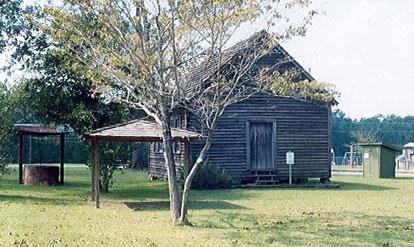
The Forrest Monroe, Sr., Heritage Educational Site
“Midway Elementary County Grade School”
Garrison Pilcher School Campus – Hall Road
A gabled front vernacular wood, one room school house, this school came from the Midway community and was donated to the Thomas County school system by Mr. Forrest Monroe, Sr., in 1976. Mr. Monroe, a Black building contractor and dedicated Black leader in this community.
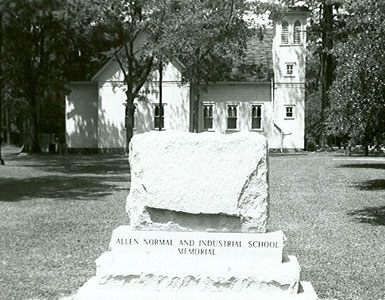
Allen Normal and Industrial School’s Memorial Landmark
1122 Lester Street
The school was built in 1886 and closed in 1933. See additional information about this school under, Bethany Congregational United Church Of Christ. Rev. Andy Young was pastor of this church in the mid 1950s before he became the United States Ambassador to the United Nations and the Mayor of Atlanta, Georgia.
Susie H. Dunlap Elementary School
1000 Lester Street
(Formerly named the Normal Park Elementary School). This was an all black school for many years until integration of the Thomasville City School system in 1970.

Recreation Center
400 West Calhoun Street
A gabled one story and a half brick and wood vernacular house with segmental brick arches over the first floor windows and massing derived from “colonial” pronto types, the Recreation Center was built by Mr. W. E. Gibson in the 1920’s. The purpose of the house was to furnish a place where young black people could get together to socialize and have fun. The center consisted of three rooms and a large room where the youth could dance. In this room were a piano and chairs around the walls. The next room was the game room, containing a pool table and chairs. There was a kitchen where refreshments were served. Local clubs and industries often had social affairs in this building. In the back yard was a swimming pool where many children were taught to swim. The center served the community for about ten years. The owner tried to operate a community store but failed. Mr. Gibson deeded the building to his son Carlton for $1.80. Carlton Gibson raised the flat roof and added four rooms. He also filled the pool to make room for parking cars. In 1938, Carlton Gibson and his family moved into the house as it stands today, and it became the first brick house for an African-American in Thomasville.
Clay Street First YMCA For Blacks
Corners of Pine and West Calhoun Streets
A gabled front vernacular wood school, this structure was later used as Douglass High School’s extended classroom. The late W. J. Varner, principal of Douglass High School, was the first part-time YMCA secretary. On May 1, 1928, it became the Colored YMCA.
Francis F. Weston Park
Felix Street
The Harvard family donated this land to the YMCA in 1948. In 1978 or 1979, it was leased to the City of Thomasville and was developed into a park. The park was named and dedicated in the memory of the late Francis F. Weston, who dedicated over 40 years to working for the local YMCA. Felix Street (where the park is located) and Festus Streets in this community called Dewey City.
Francis F. Weston YMCA Center
416 West Clay Street
This YMCA center is named in honor of an African-American, the late Mr. Francis Franklin Weston. The center was named in his honor in October of 1984 for his untiring work in the YMCA for over 40 years. In 1964, the local black and white communities raised over $125,000 to build this YMCA in the black community. The YMCA was first called the Clay Street YMCA because of the clay banks and dirt on Clay Street. It has provided outstanding and great service to youth in the black community over the years.
Thomas County Historical Society and Jack Hadley’s Black History Memorabilia, Inc.
725 North Dawson Street
The African-American Life on the Southern Hunting Plantations–1900 thru 1940, Lt. Henry O. Flipper’s Exhibit and the Allen Normal and Industrial School exhibit are located at this museum. Small fee to see the museum. Call 229-226-7664.

Thomasville Masonic-Prince Hall Lodge
518 Lester Street
A two-story gabled end vernacular Masonic Temple building with simplified classical entry portio, the Thomasville Masonic-Prince Lodge Hall is the oldest black Masonic lodge in Thomas County. The structure was built in circa 1904 by Brother Trailor, a member of Joppa Masonic Lodge No. 43. During the 1920’s and 30’s, it was used as a community kindergarten school. The first teacher was Ms. Mattie Rollins. Joppa Lodge No. 43 and S.P. Jones Lodge No. 118 remodeled the Lodge Hall in 1995 jointly. There is a permanent pictorial Masonic “Wall of Fame” an exhibit that can be seen by groups in this lodge hall by appointment. Please call (229-226-5029) or email jackhadleyblackhistorymuseum@rose.netto make arrangements for a group tour.
Rev. Frank D. Martin, Sr. Memorial Park
Corners of Fourth Avenue and Magnolia Street
This is the Old Providence Missionary Baptist Church Site. The old framed church was built in 1907 and was founded by Mother Mary Williams as a Prayer House. The late Rev. Frank D. Martin, Sr. pastored the old church for 40 years. Mrs. Williams is buried in the Old Magnolia Cemetery on North Madison Street. In 2007, the Providence Missionary Baptist Church erected a memorial monument in honor of Mrs. Williams, the organizer of Providence Missionary Baptist Church in 1907.
Historical Black Business District
300 Block, West Jackson Street
A separate section of this historic district developed around the turn of the century to serve Thomasville’s black community. “The Bottom” as it was called was the hub of the black business community. (Listed on the National Register). Redevelopment is underway.
Ritz Theater Site
323 West Jackson Street
The Ritz Theater served as the main entertainment center for African-American residents and surrounding communities for many years. The theater site was owned by the Heritage Foundation, Inc. and had a restoration project underway until a decision by the foundation to have it demolished because of the cost to restore. The property is now owned by the city of Thomasville.
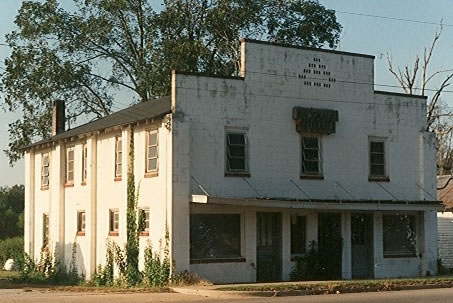
Imperial Hotel
704 West Jackson Street
Built by the Lewis brothers in 1949 and operated until 1969 by Harvey and Dorothy Lewis Thompson, the Imperial Hotel is the only known black hotel in Thomasville’s history. Until the end of segregation in public accommodations, African-American’s could not stay in public hotels. When entertainers such as the King Perry Band, B.B. King, The Five Blind Boys of Mississippi, Earl Bostic, Bells of Joy, Rosetta Thorpe and Marie Knight all came to Thomasville, they had to stay at the Imperial Hotel.

622 North Broad Street
Hadley Funeral Home, Inc.
622 North Broad Street
A Craftsman style brick gabled front cottage with projecting porch, this structure is the oldest black owned funeral home in Thomas County. This business was formally known as Randall and Jordan Funeral Home. Guite Hadley bought this business and moved it from West Calhoun Street to its present location. W. E. Jackson, Israel Hamilton and Elmo Hadley were the first morticians followed by John Brown. The first rolling stock was a LaSalle ambulance. Roscoe V. McGriff was the driver on calls. The funeral coach was an S&S Coach.
THOMASVILLE IS WORTH THE TRIP!
~ STEP ON – STEP OFF ~
Thomasville Black Heritage Trail Tour
The Jack Hadley Black History Memorabilia, Inc. will make your VACATION/REUNION visit a pleasurable one while you are visiting the great city of Thomasville. “The City of Roses.”The city that is worth the Trip!
We will step aboard your chartered bus, school bus, van or private vehicle and broaden your knowledge of the African – American Historical Sites here in Thomasville, Georgia.
To Schedule a ~STEP ON – STEP OFF~ Thomasville Black Heritage Trail Tour or to receive more information, contact:
Jack Hadley Black History Memorabilia, Inc.
James “Jack” Hadley
214 Alexander Street
Thomasville, GA 31792
Office phone 229-226-5029 & FAX 229-226-5084
Email: jackhadleyblackhistorymuseum@rose.net

Tour bus by Richard William’s home
310 Magnolia St
Mr. Williams was one of the first three black letter carriers in Thomasville in the 1900’s.
Credits & Acknowledgements
The staff of Rose.Net expresses its sincere thanks to Jack Hadley’s Black History Memorabilia, Inc. for allowing us to use the information from the Thomasville Black Heritage Trail Tour Guide.
On behalf of Mr. Jack Hadley: Sincere thanks to the Gardner Family Reunion, July 21-25, 1995. This was the first family to test run this tour guide. They reported, “It was a great success for the family reunion.” Special thanks to Mr. Dave Eden, Director of the Thomas County Library System; Mrs. Lucille G. Morris, member of the Thomasville City Board of Education; Mr. Rodney Braswell, Instructor Drafting and Design, and Ann Anderson McCant, a student at Thomas Technical Institute; Dr. Homer Pankey, President of Thomas College; John Serven Hand, Architect; Mrs. Doris Walton Booker; Mr. Willie Johnson; Mrs. Irsle Flipper King, Lt. Flipper’s niece; and Mayor Camille L. Payne. Photographs courtesy of all of the property owners who gave me permission to take pictures of their historical sites. A special thanks to Ms. Jeannine B. Vicks, principal Douglass Elementary School and my loving wife, Chris Hadley, for her constant support. Many thanks to all the sponsors and friends whose generous contributions made the Thomasville Black Heritage Trail Tour Guide possible.
